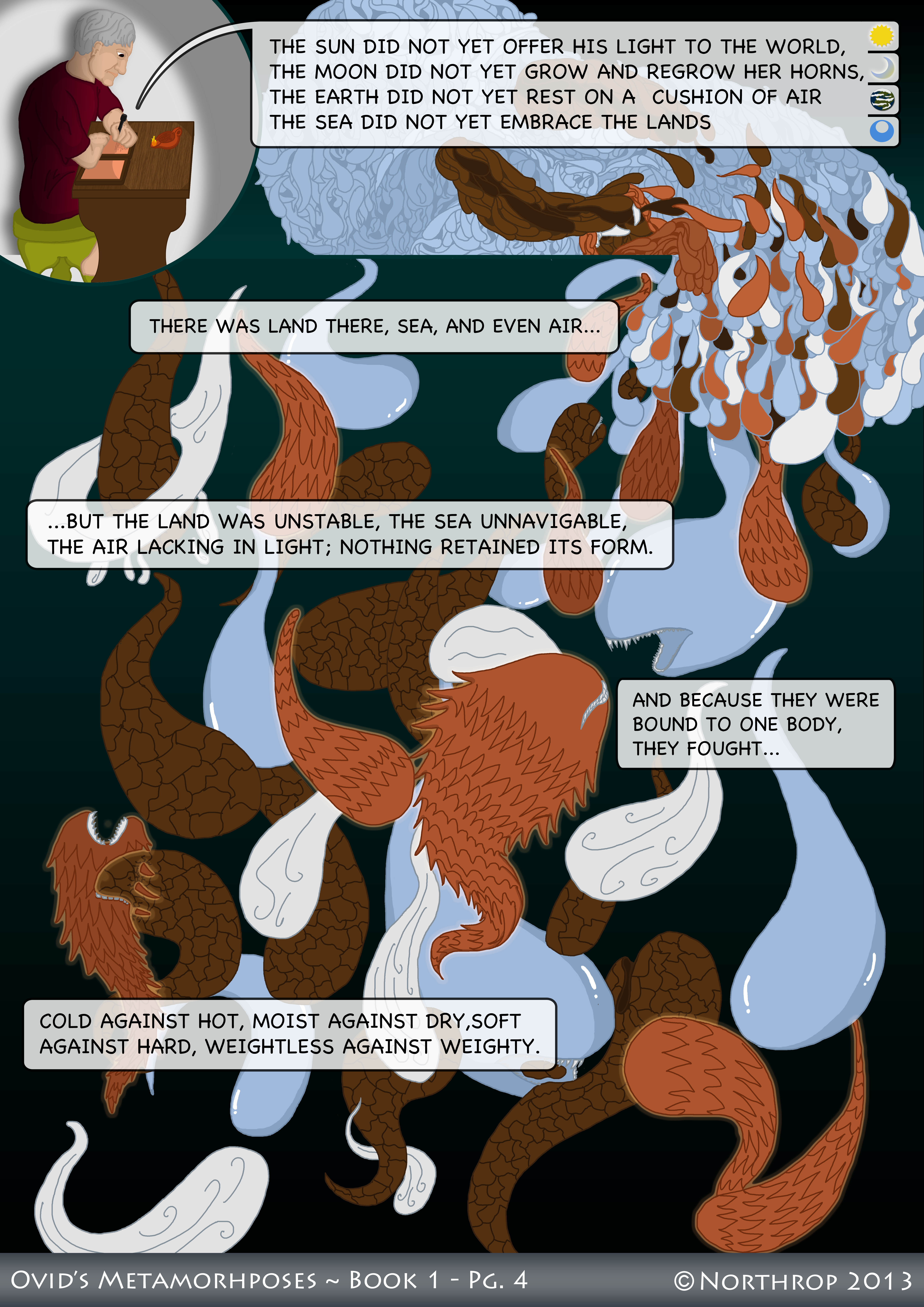Met. 1.10-20 – Battle of the Elements
NULLUS ADHUC MUNDO PRAEBEBAT LUMINA TITAN
NEC NOVA CRESCENDO REPARABAT CORNUA PHOEBE
NEC CIRCUMFUSO PENDEBAT IN AERE TELLUS
PONDERIBUS LIBRATA SUIS NEC BRACCHIA LONGO
MARGINE TERRARUM PORREXERAT AMPHITRITE.
UTQUE ERAT ET TELLUS ILLIC ET PONTUS ET AER
SIC ERAT INSTABILIS TELLUS, INNABILIS UNDA,
LUCIS EGENS AER; NULLI SUA FORMA MANEBAT
OBSTABATQUE ALIIS ALIUD, QUIA CORPORE IN UNO
FRIGIDA PUGNABANT CALIDIS, UMENTIA SICCIS,
MOLLIA CUM DURIS, SINE PONDERE HABENTIA PONDUS.
NO TITAN AS YET OFFERED LIGHT TO THE WORLD;
NOR DID PHOEBE RENEW HER HORNS BY GROWING THEM;
NOR DID THE EARTH HANG SURROUNDED BY AIR
BALANCED BY HER WEIGHT; NOR ALONG THE LONG
EDGE OF THE LANDS DID AMPHITRITE STRETCH OUT HER ARMS.
AND AS THERE WAS EARTH THERE, AND SEA AND AIR,
SO WAS THE EARTH UNSTABLE, THE WAVES UNNAVIGABLE,
THE AIR LACKING IN LIGHT; NOTHING RETAINED ITS OWN FORM,
AND ONE THING OCCUPIED THE PLACE OF ANOTHER, BECAUSE THEY WERE IN ONE BODY
COLD FOUGHT WITH HOT, WET WITH DRY,
SOFT WITH HARD, WEIGHTLESS WITH WEIGHTY.
This is where the commentator customarily makes a note about neologisms; far be it from me to break tradition! Ovid seems to have invented two words for this passage (although given the rather limited corpus of extant Latin, these pronunciations are always slightly tenuous): “instabilis” (literally: “unable to stand”) and “innabilis” (literally: “unable to be swum in”). Geez, those translations are mouthfuls, huh? I’ve rendered them (both in the comic and in my translation) as “unstable” and “unnavigable”, respectively. Not perfect translations, but probably their closest analogues in modern English… Check out Barchiesi and Bömer for more! (assuming you read Italian and/or German; sorry…)
This is another page that might at least raise the eyebrows of a few Ovidian scholars. A lot of translators render the word “pugnabant” (line 19) as “strove”. However, I chose the word “fought”, because, on the one hand, it is closer to the very militaristic Latin word; and on the other hand, it conveys the visceral violence that defines Chaos. Violence is a constant theme of the poem (just read my disclaimer over on the left!), and it all begins here with Chaos. Richard Tarrant (Harvard) emphasises that Chaos in Ovid is defined by blurred boundaries and conflict (Tarrant, 2002, pp. 350). It is also important to remember that Ovid emphasises Chaos as collection of individuals (elements). Together, in my mind, these attributes have the quality of a battle, in which all the sides are convulsing in a crowd, desparately attacking each other in mortal combat. Meanwhile, the forms of the elements come from a variety of sources, but are meant to resemble sperm to a certain extent (the Latin word for them is “semina”, which means both “seeds” and “sperm”, as well as “atoms” in Lucretius, on whom Ovid is drawing in this passage). It’s a pretty obvious pun, but the Romans were fond of making it too, so I feel kinda vindicated. I also think it gives them a fairly primal appearance, and the squirming movements of sperm just feel chaotic to begin with, which suits the elements’ natures over all.
Those good girls and boys who read the Latin and the translation will probably notice that this is where I begin deviating from the Latin somewhat. For one, I have had to simplify the names of the Sun (“Titan”, also known as “Sol” or “Phoebus”), the Moon (“Phoebe”, also know as “Diana”, or “Artemis” in Greek), and the Sea (Here represented by “Amphitrite”, wife of Neptune). The Metamorphoses is full of these sorts of allusive* names. Aside from the simple explanation of metrics** (it’s poetry after all; he needs the right number of syllables in both long and short, in the right order), there is a ‘game’ that Ovid is playing here. He demands a lot from his readers, and in the tradition of “Hellenistic” literature (which represented an increased fascination in Western literature with the wider world) he drops names left and right and asks the reader to guess his reference. Ovid may be particularly fond of this common technique of Classical literature, but it indicates that his target audience did indeed possess a wide and keen knowledge of mythology. However, with the distance of time, these references have become more and more obscure. This is one of my hopes for the project of including more literal translations with the comics: that we can draw connections between the familiar and remotely ancient, to bring the past to life.
* “Allusive” in classical jargon refers to something in a story that is specifically trying to make you think of another story or factoid from myth/legend/history.
** “Metrics” refer to the arrangement of long and short syllables in poems. It’s a very difficult task, which often results in wierd wordings and vocabulary choices. If you’ve ever tried to write a song or poem (even a haiku), you’ll know how annoying this can be…

This is a tremendous amount of work to make this accessible. I didn’t know the names of those gods and how they all reference the same thing.